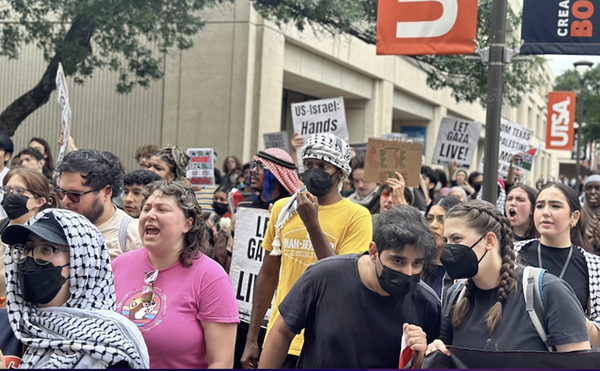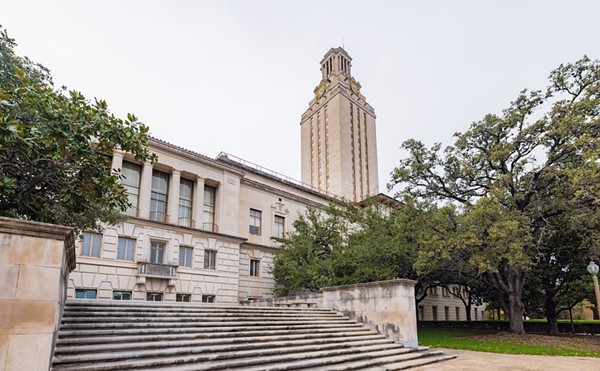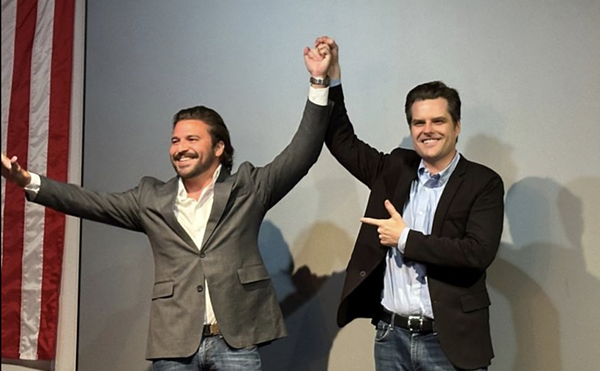Rogelio Carlos carried a camera as he walked around his family’s far Westside lot on May 20, 2014, checking in on construction of his new family business. When he looked up, he saw a red truck in the distance. It was moving fast, coming straight at him.
Carlos swore in a complaint to the San Antonio Police Department that the man driving the truck stopped just short of hitting him, got out and started barking orders. Carlos was confused and hesitated; he had no idea the man shouting at him was an undercover cop. Soon enough, two uniformed SWAT officers flanked the plainclothes detective. Carlos says he quickly dropped to the ground, yelling, “This is my property.”
Turns out Carlos got caught in the path of a police chase and, unfortunately enough for him, matched the description of the suspect police were after – namely, he was Latino and wearing a white T-shirt. The actual suspect, wanted for felony domestic assault, had ditched his car nearby; officers feared he could be armed after they found a baggie of meth and a short-barrel shotgun in the front passenger seat. When police found the real suspect just south of Carlos’ property, he was carrying shotgun shells in his pockets but no weapon. After the officers realized their mistake and un-cuffed him, Carlos asked why they had to beat him. According to his complaint, one of them simply explained, “You fit the profile.”
Carlos walked away with a gash above one eye, severe brain swelling, a broken tooth and neck pain so intense that after a year and a half of physical therapy that didn’t work, his doctors recommended an operation – which, due to complications, left him largely paralyzed. The officers who beat Carlos so badly he needed spinal surgery – identified in court records as Carlos Chavez, Virgilo Gonzalez and a “Detective John Doe,” who SAPD won’t identify due to his undercover work – were cleared of wrongdoing by the U.S. Department of Justice last year. Carlos’ family filed a federal civil rights lawsuit against the officers and city that continues to drag on in court.
SAPD first considered a "contemplated" suspension of 15 days for the officers accused of chasing down and beating the wrong guy. The department's citizen review board, however, recommended reducing punishment after seeing the case, and San Antonio Police Chief William McManus agreed to suspensions of just five days.* Not that they’d actually miss any work – the officers just took it out of their accrued vacation time, a perk allowed by the deal their union first struck with the City of San Antonio decades ago.
What does a case like Carlos’ do to public trust in the police? That question is at the heart of a conversation San Antonio city leaders are now just starting to have in the form of a new “Council on Police-Community Relations” that began meeting last fall. Mayor Ivy Taylor says she created the group with the hope of building mutual trust after a bitter 2016 – a year marked by more high-profile deaths at the hands of law enforcement; more nationwide protests over police violence; targeted killings of officers that left even more law enforcement officials on edge; and a dustup with the local police union that seems to have only underscored the distrust.
“We have had our share of incidents,” Taylor told the Current, “and we wanted to have the opportunity to talk about some of those challenges and see how we could strengthen relationships between police and community members.”
In some ways, it’s a conversation years in the making. Outside investigations and audits that revealed serious, structural problems within SAPD several years ago set San Antonio on a slow path to police reform before many big-city departments were even forced to consider it. The city prides itself in having undergone a series of changes in the past several years, including increased officer training and more civilian oversight of the department’s disciplinary process. And last year, the department was one of 15 selected to participate in a White House-driven reform effort called “Advancing 21st Century Policing.” In fact, McManus and local police union leaders argue that there’s not even really a problem here – that is, except for maybe “public perception” of the police.
Both McManus and union officials told the Current they hoped the mayor’s task force will actually emphasize the kind of “community education” that teaches citizens how to appropriately deal with police; McManus, in particular, argues that if people were more aware of the reforms SAPD has undertaken in recent years, trust between police and policed would be a non-issue.
Activists and reformers, meanwhile, insist that last year’s conflict over the city’s contract with the San Antonio Police Officers Association – which a city council majority passed without any reforms to police discipline or accountability measures – only highlights tensions that have existed below the surface for generations. They also point to a string of officer misconduct cases in recent years (including an officer recently fired for trying to feed a homeless person an actual shit sandwich) as further sign that reforms and strict punishment for what the city likes to call “bad apples” are still sorely needed.
Some of those activists invited to the mayor’s task force have been frustrated by the process; others have even dropped out, saying the group is talking in circles and avoiding some clearly-defined issues that, while maybe not unique to San Antonio, should be at the heart of any conversation around policing here. Like the fact that, according to an Express-News analysis last year, cops here use force disproportionately against people of color. Or, as shown by Carlos’ case, the reality that officers might beat you so bad you’ll need spinal surgery if they mistake you for a suspect – and, if you complain afterward, their “suspension” might not even include time off the clock.
Mayor Taylor says it was in part the public reaction to last February’s killing of Antronie Scott – an unarmed black man shot to death while police were trying to arrest him on a felony warrant – that helped convince her of the need to build trust between the police and community. While McManus initially said he’d fire SAPD officer John Lee for shooting and killing Scott (Lee says he mistakenly thought Scott’s cell phone was a gun), the chief ultimately backtracked amid intense pressure from a police union that, like many across the country, maintains that reforms are starting to threaten effective policing.
For officer Jackie Neal, it didn’t matter that the 18-year-old was 22 years younger than him, that she was still a senior at Reagan High School, or that he was supposed to be her mentor under the police department’s “Explorer” program for future cadets. According to court filings, the girl later told investigators Neal was like a father figure because she didn’t know her real dad.
When the department found out Neal was having sex with a high school student, his supervisors issued a no-contact order – which Neal promptly violated when he texted the girl congratulations for completing the Explorer program. In September 2013, Neal was issued a three-day suspension and bumped to night shift. Neal used up some accrued vacation time so he didn’t actually have to miss any work.
Two months later, Neal was patrolling the Southside when he pulled up behind a 19-year-old woman. According to a lawsuit she later filed in federal court, Neal followed her in his cruiser for several blocks before he turned on the flashing lights, pulled her over, and accused her of driving a stolen car. Neal asked if she had any drugs on her before he ordered her out of the car, handcuffed her and searched the vehicle. When he walked her around to the trunk of the car for a pat down, she asked him to call a female officer out to the scene to conduct the search. She says Neal reached into her shirt and fondled her breasts for several minutes before he started taking off her pants.
After he raped her, the woman claims Neal warned her not to say anything because he knew where she lived. Apparently, it wasn’t an empty threat. After the woman contacted police, Neal got an email notifying him he’d been placed on administrative duty. According to department disciplinary records, Neal called a sergeant friend who told him what the allegations were. Neal then drove to a nearby police substation, where he used a fellow officer’s login to pull up the woman’s information on a department computer. According to the lawsuit, Neal stopped by the woman’s house looking for her while she was at the hospital undergoing a rape kit and being questioned by police.
Should Neal have still had a badge by the time he assaulted the woman? His short, sort-of suspension for having sex with a high school student he was supposed to mentor at the department wasn’t even his first complaint on record with SAPD. Yet an expert later hired by the city to review the case – former SAPD Police Chief Albert Ortiz – concluded that while Neal’s sexual relationship with the girl was “distasteful and discouraging,” it was neither a fireable offense nor reason for department officials to think Neal might later commit serious misconduct on duty. McManus later testified in a court deposition that at the time he had a “stern conversation” with Neal about having sex with the high schooler, but that he never actually considered firing him.
Neal’s arrest in 2013 on rape charges actually underscored a problem at SAPD that city leaders had vowed to fix years earlier. By 2009, about one third of officers fired for misconduct had been investigated for sexually-motivated offenses, triggering an external review of the department that concluded officer supervision was “a significant issue” at SAPD. By 2010, McManus had announced he’d shuffle some administrative duties away from field supervisors and add more sergeants to directly watch over officers. A 2010 report by the Matrix Consulting Group commissioned by the city manager’s office also warned that the department seemed to have a culture in which front-line officers “do not welcome supervisory presence.”
Because of how the department publicly reports its numbers, it’s not clear how many of the hundreds of sworn complaints against police officers every year result in disciplinary action. What is clear, however, is that plenty of officers are still being fired or disciplined because of problems that involve, among other issues, complaints of sexually motivated misconduct – which McManus says is to be expected. “We are a very large organization,” he told the Current. “We are going to see officers getting in trouble.”
In the lawsuit Neal’s victim filed against him in federal court (which the city ultimately settled for half a million dollars), she referenced seven other cases over a four-year period involving SAPD officers accused of raping, fondling, or exposing themselves to women while on and off duty. Disciplinary records that are publicly available from the past two years show the department has delivered one-to-five day suspensions for other officers accused of everything from meeting up with and groping match.com dates while on duty to threatening ex-girlfriends with so-called “revenge porn.” Even after the disturbing example set by Neal, an officer was suspended for just 10 days last year after he was accused of groping the breast of an 18-year-old in the department’s Explorer program. (Local TV station KSAT recently created a database of all officer suspension records from the past two years; SAPD evidently won’t host the database on its own department website.)
SAPD’s Internal Affairs department separates complaints into two silos: formal complaints, which accuse the officer of “a significant variance from normal behavior,” and line complaints that the department considers to be “minor.” For 2015, the most recent year for which a report is available, there were 174 formal complaints and 373 line complaints. Use of force incidents tracked by the department skyrocketed in 2014 from 760 the year prior to 1,189, likely because officers were finally required to report so-called “takedowns” of suspects in the field (which, according to the department, is defined as “a leg sweep, body flip or similar control technique intended to control an individual who is offering resistance during arrest and handcuffing”). While department officials contend the reporting change makes use of force numbers look inflated, activists say the new stats give us a better understanding of how many people actually encounter police violence every year.
After the February 4, 2016 shooting of Antronie Scott, local leaders eagerly wanted to avoid the kind of mass demonstrations that followed police shootings in other cities. McManus and officials with the city manager’s office went before the Express-News editorial board and announced their plan to fire officer John Lee for placing himself “in a vulnerable position where he didn’t give himself time to react,” resulting in a fatal mistake. Lee claimed he approached Scott from behind, demanded that he show his hands, and quickly fired when Scott turned around instead. McManus seemed frustrated, caught between rank-and-file officers who wanted his support and a community that demanded action.
McManus also assured the daily’s editorial board that Lee hadn’t actually breached the legal standard that courts use to judge police violence; however, the chief also publicly acknowledged, for what appears to be the first time, that the community now seems to want to hold cops to a standard higher than not-unconstitutional and not-criminal. Later that year, members of Mayor Taylor’s task force on policing would actually meet behind closed doors at the local FBI field office, where they heard officials with the U.S. Department of Justice and the Bexar County District Attorney’s Office explain why, due to how judges have ruled on the issue over the years, it’s so hard to prove excessive force in either criminal or civil court.
The police union was livid that McManus referred to Scott’s shooting as “lawful but awful” in his comments to the media. The end result was like the worst of both worlds. McManus ultimately reneged and decided more training, not punishment, was the right call for officer Lee.
Meanwhile, the following month, some 97 percent of police union members (or roughly 2,000 San Antonio cops) signed onto a union vote saying they had no confidence in McManus’ ability to lead the department. McManus and Mayor Taylor caution against taking the no-confidence vote, or the union’s accompanying 12-page report explaining it, too seriously because it happened in the throes of a contentious contract negotiation process.
Still, Dean Fischer, the SAPOA vice president who now sits on the mayor’s police-community relations task force, says officials would be wrong to dismiss the report. “They wanna say that vote was all about us trying to score a better contract – that’s simply not true,” he told the Current.
In its report, the union accused McManus of “poisoning the community” against their fellow officer. They also accused their chief of opening the department up to reforms that would “endanger the lives of police officers.”
Records state that Aragon sprayed Garza’s unmarked police car with bullets, with one striking Garza’s girlfriend in the abdomen. Despite having a wounded passenger, Garza chased Aragon for nearly two miles. Garza shot Aragon in the back, killing him as he tried to run inside his northwest side home.
McManus actually filed a murder charge against Garza, but a grand jury wouldn’t indict him. In a suspension letter four months later, McManus tried to fire Garza for drinking on the job and lying about details of the shooting, among other violations.
Only McManus couldn’t actually fire him. Garza got his job back with the department in 2015 after he appealed his firing to an arbitrator under a provision embedded in the city’s collective bargaining agreement with the police union. According to SAPD, at least five fired officers like Garza have successfully appealed to get their jobs back over the past decade; there are at least 10 officers currently appealing their firings in arbitration.
That provision, which essentially strips the chief from final hiring and firing decisions, wasn’t even on the table when Mayor Taylor went into court-ordered contract negotiations with the police union last year – but some other reforms were. Amid public outcry over cases like Antronie Scott’s shooting, Taylor says she asked the city manager’s office to come up with some disciplinary reforms to bring into negotiations with union officials. Among the city’s suggestions were reforming internal affairs procedures that heavily favor accused officers facing discipline; the contract provision that lets officers forfeit accrued leave in lieu of an actual suspension (which both Jackie Neal and the officers who beat Rogelio Carlos benefitted from); and a curious policy that automatically reduces officer suspensions of three days or less to written reprimands after two years (a policy that some elected leaders have even called government-sanctioned falsification of records).
In the end, the union wouldn’t even budge on that last policy, which Black Lives Matter activists like Mike Lowe, who led marches on city hall last year during the contract debate, considered the lowest of the low-hanging fruit of police reform – accurate record-keeping in the police disciplinary process. Lowe eventually stopped going to the mayor’s task force meetings after they failed to even bring up the union contract and the protections it affords officers. People like Lowe question what the task force can even accomplish unless it both reviews cases of officer discipline and the union contract.
“I think what the mayor wants is to create an atmosphere where people can say, 'Yes, yes we trust the police,'” Lowe told the Current after a meeting last month. “I don’t necessarily have a problem with that, but how do you have a conversation like that without discussing the specific things we keep bringing up that, to us, show that the police have done wrong?”
Fischer with SAPOA naturally takes a different view. In fact, he claims some of the reforms that have been embraced by city leaders are just “motivated by political correctness, media hype and overreaction.” McManus, for instance, has called for training officers with a new strategy for police encounters that reformers call “LEED” – short for “listen and explain with equity and dignity.” Fischer calls such policies “half-baked,” saying he prefers the old “ATM” method (short for “ask, tell, make”).
McManus actually contends that big, sweeping reforms aren’t even really necessary right now. He pointed to a list the city manager’s office passed out at the task force’s first meeting, which outlined about eight reforms the department has made to policies or procedures over the past decade. They include policies that require officers to respond more quickly to domestic violence calls and 2008 reforms to the department’s citizen complaint process (like that complainants can now be accompanied by another person, whether for legal reasons or moral support, when they attend an officer’s disciplinary proceeding). He also points out that SAPD boosted civilian oversight of its internal review process when the city negotiated its last union contract in 2009, adding the number of civilians assigned to the review board that evaluates cases like officer shootings.
So far, what’s been discussed at the mayor’s task force meetings has been pretty vague. At January’s gathering, the group’s fifth, the members actually broke out into individual sub-groups that are supposed to come up with some specific policies or recommendations that Mayor Taylor says she wants to present to city council’s public safety committee in the coming months.
Judging from the meetings thus far, it’s almost impossible to tell what those specific policies or recommendations might look like – or, for that matter, whether they’ll even address the concerns that drew protesters out to city hall last year. Fischer says he hopes to communicate one simple idea during the task force meetings – that the community needs to be “educated” to comply with police orders. The lesson to be learned from Antronie Scott’s shooting, he says, should be that if you have outstanding warrants, turn yourself in before police have to come find you. Among other lessons the police union hopes to bring out at the task force meetings, according to Fischer: “If I have to chase you, it’s your fault. If I have to fight you, it’s your fault. If I have to shoot you, it’s your fault.”
At a council briefing earlier this month, McManus actually brought up another issue that the mayor’s task force will probably have to broach at some point if they really want to build trust – not just from the community, but from the police. McManus told city council’s public safety committee that the public’s increased scrutiny of law enforcement has created what he calls “hesitancy of response.”
He gave an example to illustrate the point. One recent day, while driving into the office, McManus got a call about a homeless woman who wouldn’t stop trespassing outside a local business. He was the one who had to make the arrest. *When he tried to take the woman into custody, however, she recoiled and the two struggled. The chief told council members that what was apparently a new thought entered his mind: What if someone’s catching this on video? “Am I going to become the next viral video?” he said.
It’s actually more hesitation that people like Diane Peppar, Antronie Scott’s mother, want from police during law enforcement encounters. After her son’s death, Peppar says she just wanted to know why the officer was afraid enough to shoot and kill her son. “Why was he so trigger-happy? What was he so afraid for? I lost my son, my one and only,” Peppar said. “It’s a hard pill to swallow.”
—
*Correction 2:30pm: It was the department's review board, not Chief McManus, that recommended reducing the officers' suspensions. SAPD spokesman Jesse Salame also says McManus only had "a brief struggle" with the woman he tried to arrest and the two never ended up on the ground, as initially reported. The Current regrets the error.



















